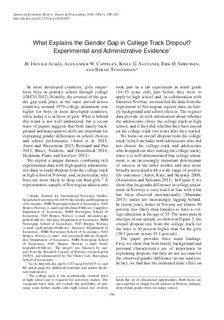| dc.contributor.author | Almås, Ingvild | |
| dc.contributor.author | Cappelen, Alexander Wright | |
| dc.contributor.author | Salvanes, Kjell Gunnar | |
| dc.contributor.author | Sørensen, Erik Øiolf | |
| dc.contributor.author | Tungodden, Bertil | |
| dc.date.accessioned | 2016-10-10T10:46:01Z | |
| dc.date.accessioned | 2016-10-12T08:43:51Z | |
| dc.date.available | 2016-10-10T10:46:01Z | |
| dc.date.available | 2016-10-12T08:43:51Z | |
| dc.date.issued | 2016 | |
| dc.identifier.citation | Almås, Ingvild, Alexander W. Cappelen, Kjell G. Salvanes, Erik Ø. Sørensen and Bertil Tungodden. 2016. "What Explains the Gender Gap in College Track Dropout? Experimental and Administrative Evidence." American Economic Review, 106(5): 296-302. | nb_NO |
| dc.identifier.issn | 0002-8282 | |
| dc.identifier.uri | http://hdl.handle.net/11250/2414446 | |
| dc.description | --Copyright © 1998, 1999, 2000, 2001, 2002, 2003, 2004, 2005, 2006, 2007, 2008, 2009, 2010, 2011, 2012, 2013, 2014, 2015, 2016 by the American Economic Association. Permission to make digital or hard copies of part or all of American Economic Association publications for personal or classroom use is granted without fee provided that copies are not distributed for profit or direct commercial advantage and that copies show this notice on the first page or initial screen of a display along with the full citation, including the name of the author. Copyrights for components of this work owned by others than AEA must be honored. Abstracting with credit is permitted. The author has the right to republish, post on servers, redistribute to lists and use any component of this work in other works. For others to do so requires prior specific permission and/or a fee. Permissions may be requested from the American Economic Association Administrative Office by going to the Contact Us form and choosing "Copyright/Permissions Request" from the menu. Copyright © 2016 AEA | nb_NO |
| dc.description.abstract | We exploit a unique data set, combining rich experimental data with high-quality administrative data, to study dropout from the college track in Norway, and why boys are more likely to drop out. The paper provides three main findings. First, we show that family background and personal characteristics contribute to explain dropout. Second, we show that the gender difference in dropout rates appears both when the adolescents select into the college track and after they have started. Third, we show that different processes guide the choices of the boys and the girls of whether to drop out from the college track. | nb_NO |
| dc.language.iso | eng | nb_NO |
| dc.publisher | American Economic Association | nb_NO |
| dc.title | What Explains the Gender Gap in College Track Dropout?Experimental and Administrative Evidence. | nb_NO |
| dc.type | Journal article | nb_NO |
| dc.type | Peer reviewed | nb_NO |
| dc.date.updated | 2016-10-10T10:46:01Z | |
| dc.rights.holder | Copyright © 2016 AEA | nb_NO |
| dc.source.pagenumber | 296-302 | nb_NO |
| dc.source.volume | 106 | nb_NO |
| dc.source.journal | American Economic Review | nb_NO |
| dc.source.issue | 5 | nb_NO |
| dc.identifier.doi | http://dx.doi.org/10.1257/aer.p20161075 | |
| dc.identifier.cristin | 1355665 | |
